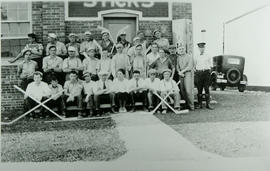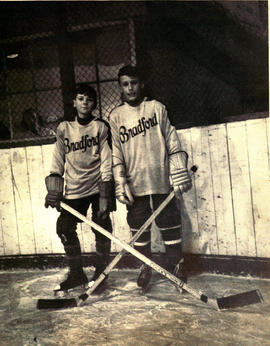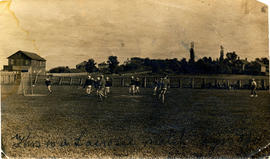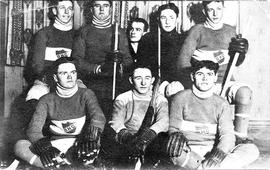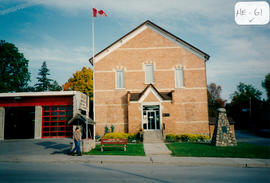Collings, Benjamin Briton obituary
- CA BWGPL VS-1900-18841
- Item
- 1957-07-31
Part of Vital Statistics
Event Date : Saturday, July 27, 1957
Event Type : Death
Description : The end came suddenly for Bradford's veteran, and well-known townsman, Benjamin Briton (B. B.) Collings, last Saturday morning. During the past year Mr. Collings had shown some signs of his advanced years, but the firm step, the indifference to weather conditions, and the ready reply to all greetings, remained with him to the last. He had not been well for a week or more, but on Thursday he was downstairs in his home and returned to his room unaided. Friday he acknowledged he was tired and stayed in bed and on Saturday morning he was dead. He never had pain. He kept going to the last, and just quit. B. B. Collings was looking forward to the Centennial celebration and meeting old friends, and to many who are returning, Bradford has lost one of the interests for them, in his passing. Few will disagree that he was the most colourful character in Bradford. He knew everyone, and everyone knew him. He had a greeting for everyone, a greeting which seldom was particularly complimentary, but because it was B. B. Collings' remark, it was accepted with a laugh. Few days passed that those whose duties caused them to be about the street, did not have a few words with B. B.
"Mr. Collings was born in Bradford on August 9, 1876 the youngest member of a family of sixteen. From childhood days he was working. He told stories of the days when Amsterdam was a thriving village with its mills and he was an errand boy down there. The Collings family was associated with the Holland Marsh and did a profitable business in cutting marsh hay and selling this hay for packing and mattress making. B. B. decided that if this hay was worth Toronto mattress makers transporting it to Toronto he better get into the business. In the 1890's he went to Toronto and learned the trade and came back to Bradford and opened a little mattress making factory here where he employed some of the lacrosse players of the day. Today it is common practice for sport enthusiasts to give employment to star players but B. B. Collings began that nearly 60 years ago. He then went into the furniture and undertaking business taking a course in embalming. Then back to the marsh hay business and commercial fishing and his final business venture was the draining of what was named the Colbar Marsh area a big portion of which is now Federal Farms' gardens and in this he was singularly successful. This last project was accomplished after he was in his seventies.Mr. Collings and his men were recognized in the Lake Simcoe district as an able life-saving crew. Their business as commercial fishermen took them to all parts of the lake and the river and they were familiar with the water. Few accidents or tragedies have occured on the river or lake to which Mr. Collings and his men were not called to lend their help and they have many rescues to their credit.Mr. Collings was always keenly interested in sport particularly lacrosse and had served in official capacity on various lacrosse clubs. But few sporting events occurred in Bradford throughout the years which he did not attend whether hockey ball or lacrosse.Mr. Collings served on the Bradford Public Utilities Commission for several years and also on Bradford Board of Education.In September 1902 Mr. Collings married Etta May Waldruff of Bradford who survives him with their family of two daughters and one son namely Bernice (Mrs. Gordon Crutcher) of Thornhill; Kathleen (Mrs. Ken Blevins) of Toronto and Norman E. of Bradford. Five grandchildren also survive: Gordon Stephen and Tony Crutcher Tom Collings and Mary Jane Collings. Of the family of sixteen only two survive Dan Collings of Bradford and Libby (Mrs. Selby) of Eston Saskatchewan.The funeral was held from Bradford United Church yesterday afternoon. The services were taken by Rev. F. G. MacTavish assisted by Rev. H. P. Maitland of the Presbyterian Church and Rev. H. G. Blake of Toronto. Interment was in Mount Pleasant Cemetery. The pallbearers were C. T. S. Evans, A. L. Veale, Fred Collings, Roy Collings, Phil Latchman and James R. Webb."
Bradford Witness




